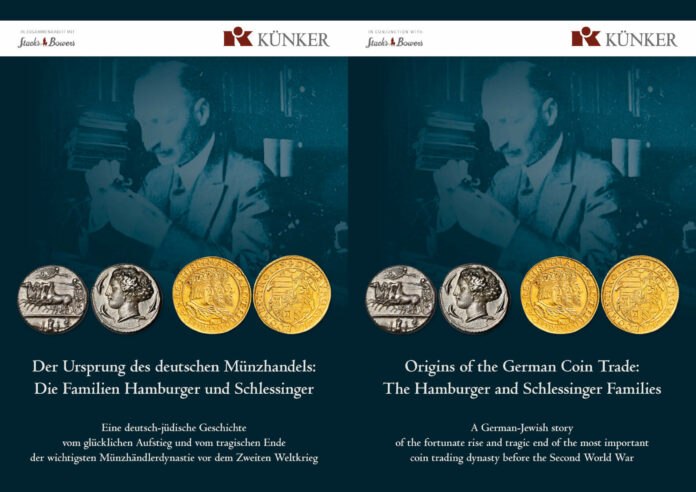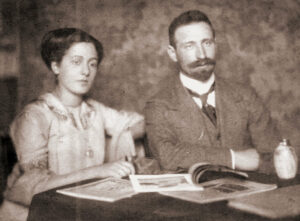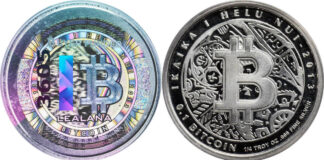
On 22 March 2022, the second part of the Lottie and Mark Salton Collection was auctioned off by auction house Künker in Osnabrück. It contained spectacular coins that are all the more spectacular due to one fact: before he emigrated to the United States of America in 1946, Mark Salton bore the name Max Schlessinger. He was the son of Felix Schlessinger, who ran one of the most famous German coin shops in Berlin in the late 1920s.

The Historical Sources
Three documents that had hitherto been unknown to most scholars came to light during the investigation of the history of the Hamburger and Schlessinger families. These documents shed a completely new light on the fate of this dynasty of coin dealers. In addition, a fourth document was found that had not been thoroughly evaluated before:
Four members of the family left their memoirs to posterity:
- Adolph Hamburger (1841-1919), brother of the company founder Leo Hamburger the Elder (1836-1902)
- Röschen Schlessinger (1844-1932), sister of Leo Hamburger the Younger, partner of the L. & L. Hamburger coin dealership (1846-1929), and mother of Felix Schlessinger (1879-1944)
- Sophie Diamant (1880-1972), sister of Felix Schlessinger
- Mark Salton resp. Max Schlessinger (1914-2005)
Thanks to these memoirs, the history of the Hamburger-Schlessinger dynasty can be traced back to a court factor called Loeb Hamburger (1761-1835) who lived in the Hanau ghetto. Through the eyes of the family members we experience the emancipation of Jews under Napoleon, the turmoil of the revolution of 1848, the industrialization and the economic upswing of the mid-19th century, the First World War, the hyperinflation of 1923, the Nazis’ rise to power, the persecution and expulsion of Jews until we get to the new beginning in the United States.

The Findings
Thanks to the analysis of these sources, it was able to gain new insights into the German coin trade prior to the First World War:
- For example, the Munich Oberndörffer bank was of utmost importance in the process of establishing the Frankfurt coin trade.
- Jewish coin trade in Germany was closely connected due to family ties. Adolph E. Hess probably also promoted the success of his Frankfurt coin dealership by means of a marital connection with a member of the Hamburger family.
- Felix Schlessinger was brought into the L. & L. Hamburger coin shop as an heir by his uncle Leo Hamburger the Younger because the only son of the company owner had committed suicide.
- The notorious Frankfurt Consortium had not been founded for the sake of making profit, its purpose was to prevent the financial ruin of the coin dealerships involved in it.
- Felix Schlessinger founded a new coin shop in Berlin because the L. & L. Hamburger company was virtually bankrupt after the period of hyperinflation.
- The actor Heinz Rühmann collected Greek coins of the finest quality and had himself represented at auctions by the Munich art dealer Otto Bernheimer.
Added to these fundamental pieces of information, the memoirs provide us with true-to-life scenes of the coin trade that clarify our picture of past auction sales.
The well-known historian and numismatist Dr Ursula Kampmann, who has been studying the history of the coin trade for many years, has written an extensive text on the history of the Hamburger-Schlessinger coin dealer dynasty. It is part of a brochure published by Künker in German and English. The brochure was shipped along with the catalogs of Künker’s Spring Auction Sales. It can also be read online or ordered from Künker at the nominal fee of 10 euros.
Dates of the Sale of the Salton Collection
| Part 1 | Ancient Greek Coins / Poland / Russia | 16 January 2022, New York, in the context of the New York International Numismatic Convention | Stack’s Bowers Galleries |
| Part 2 | European Gold Coins | 22 March 2022, Osnabrück | Künker |
| Part 3 | England | August 2022, Chicago, in the context of the ANA World’s Fair of Money | Stack’s Bowers Galleries |
| Part 4 | Ancient Roman Coins / Byzantium | September 2022, Osnabrück | Künker |
| Part 5 | Ancient Greek Coins / England | January 2023, New York, in the context of the New York International Numismatic Convention | Stack’s Bowers Galleries |
| Part 6 | European Silver Coins | January 2023, Berlin, in the context of the World Money Fair | Künker |
For more information on the Salton Collection auction, visit the Auctioneers Künker and Stack’s Bowers Galleries.
Many pieces from the Salton Collection realised extremely strong results at Künkers Spring Auction Sale 2022 Part 1.
The ANS organised a Long Table dedicated to the Salton Collection where Ursula Kampmann presented her discoveries.
A Who’s who is dedicated to Mark Salton and his family.
And a film tells the history of the Hamburger and Schlessinger coin dealer families.




